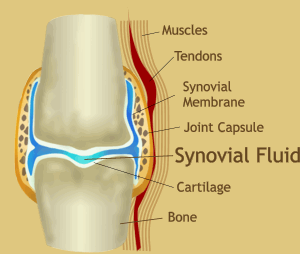Understanding Joint and Muscle Health
No matter how old you are, no matter how active or health-conscious, you can be plagued by a need to support health joint and muscles. Your happiness and quality of life can depend on it.
Why let it slow you down?
We all know healthy joints and muscles are necessary for a healthy lifestyle. The joints provide movement and cushioning in places on your body where maximum stresses occur. The muscles power your movements, but also help support and protect your joints. Taking special care of both joints and muscles is vital to maintaining the quality of your life. We also all know that as we age or stay active, if we do not take care of bodies then we have more difficulty performing the simple daily activities like walking and riding. All this can bring the quality of our life down.
Start with the Anatomy
To understand your body, one must become familiar with the anatomy of a healthy functioning joint.  Let's start off with understanding the joint capsule. The joint capsule is a thick fibrous tissue that connects the bones,
provides the outer layer of the joint and holds the fluid inside the joint cavity. The muscles serve to support the joint
capsule and to provide joint movement. The tendon is an elastic cord that attaches the muscle to the bone and assist with movement.
The synovial membrane is the inner lining of the joint capsule. It is highly vascularized and therefore is responsible for carrying
nutrients to the joint and most importantly, producing the synovial fluid. The synovial fluid is a clear viscous fluid that lubricates
the joints. It consists of blood plasma and hyaluronic acid. Without it, joint movement would be extremely painful and articular
cartilage becomes damaged. The cartilage covers the ends of the bones and absorbs most of compression and stress in the joint.
Because it is a slippery material, it allows the joints to move smoothly and easily. Overall, the parts of the joint have to work
together, but the two most important parts are the synovial fluid which provides the lubrication for the joint and the cartilage,
which absorbs the stress. When these two are damaged, joint problems are unavoidable.
Let's start off with understanding the joint capsule. The joint capsule is a thick fibrous tissue that connects the bones,
provides the outer layer of the joint and holds the fluid inside the joint cavity. The muscles serve to support the joint
capsule and to provide joint movement. The tendon is an elastic cord that attaches the muscle to the bone and assist with movement.
The synovial membrane is the inner lining of the joint capsule. It is highly vascularized and therefore is responsible for carrying
nutrients to the joint and most importantly, producing the synovial fluid. The synovial fluid is a clear viscous fluid that lubricates
the joints. It consists of blood plasma and hyaluronic acid. Without it, joint movement would be extremely painful and articular
cartilage becomes damaged. The cartilage covers the ends of the bones and absorbs most of compression and stress in the joint.
Because it is a slippery material, it allows the joints to move smoothly and easily. Overall, the parts of the joint have to work
together, but the two most important parts are the synovial fluid which provides the lubrication for the joint and the cartilage,
which absorbs the stress. When these two are damaged, joint problems are unavoidable.
What can one do to maintain health joints and muscles?
Start protecting your joints and muscles now, regardless of your age, lifestyle, or exercise habits. There are many simple ways to feel better, and to maintain healthy joint and muscle function.
- Watch your weight – excess weight is a major contributor to many health problems.
- Exercise – keep a regular exercise routine. Fit in some form of weight training or weight-bearing exercise.
- Stretch – Incorporate stretching into your exercise program. Give yourself at least 5-10 minutes of stretching at the end of every exercise session. Be sure your body and muscles are properly warmed up.
- Proper Technique – it is important to be mindful while exercising, doing yard work, or moving boxes in your garage. Use proper technique and avoid awkward movements and excessive or repetitive movements.
- Eat Well – proper nutrition is the key to any health regimen, including one for joints and muscles. Be sure to give your body a well-balanced, and nutritious diet consisting of whole foods and vegetables packed with vitamins.
- Stay Hydrated – if you are like most Americans, you do not drink enough water and you are dehydrated. Staying well hydrated is perhaps the easiest way to keep healthy.
- Routine Doctor Physicals – Often times preventions is the best answer towards staying healthy. Seeing a doctor can discover or help prevent further problems.

